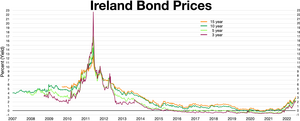
The Economic Adjustment Programme for Ireland, usually referred to as the Bailout programme, is a Memorandum of understanding on financial assistance to the Republic of Ireland in order to cope with the Post-2008 Irish financial crisis.
It was signed on 16 December 2010 by the Irish Government under then-Taoiseach Brian Cowen on one hand, and on the other hand by the European Commission on behalf of the Eurogroup, the European Central Bank (ECB) and the International Monetary Fund (IMF).
On 15 December 2013, Ireland exited the programme.
YouTube Encyclopedic
-
1/3Views:38 8057 849470
-
Saving the World Economy: Paul Krugman and Olivier Blanchard in Conversation
-
Conducting Economic Research - Health Economic Analysis and Methods
-
Link'n Learn - Derivative Financial Instruments - Valuing Complex Instruments
Transcription
Memorandum of Understanding
On 28 November 2010, European Commission, European Central Bank (ECB) and the International Monetary Fund (IMF), colloquially called the European Troika, agreed with the Irish government in a three-year financial aid programme on the condition of far-reaching austerity measures to be imposed on the Irish society in order to cut government expenditure.[2]
To avoid the legislative ratification procedures required for treaties under international law, the programme was set up as an intergovernmental agreement consisting of:
- the Memorandum of Economic and Financial Policies (MEFP),
- the Memorandum of Understanding on Specific Economic Policy Conditionality (MoU),
- and the Technical Memorandum of Understanding (TMU), the actual Loan Facility Agreement.
The agreements were signed on 16 December 2010[when?] by the Irish government and the European Commission.
Financial aid
The total amount of €85 billion would consist of €67.5 billion external support, consisting of:
- €22.5 billion from the European Financial Stabilisation Mechanism (EFSM),
- €22.5 billion from the European Financial Stability Facility (EFSF) and bilateral loans from the Euro non-member states Denmark, Sweden and the United Kingdom, and
- €22.5 billion from the International Monetary Fund (IMF)
as well as a €17.5 billion contribution from the Irish Treasury and the National Pension Reserve Fund.[3]
See also
- Post-2008 Irish economic downturn
- Post-2008 Irish banking crisis
- First & Second Economic Adjustment Programme for Greece
- Economic Adjustment Programme for Portugal
- Economic Adjustment Programme for Cyprus
References
- ^ Figure 2 within Corsetti, Giancarlo; Erce, Aitor; Uy, Timothy (2020). "Official sector lending during the euro area crisis". The Review of International Organizations. 15 (3): 667–705. doi:10.1007/s11558-020-09388-9. S2CID 225624817.
- ^ O'Carroll, Lisa (28 November 2010). "Government Statement on the announcement of joint EU - IMF Programme for Ireland". The Guardian. Archived from the original on 15 July 2014. Retrieved 5 January 2015.
- ^ "National Pensions Reserve Fund Quarterly Performance Statement". National Pensions Reserve Fund. 30 September 2010. Archived from the original on 19 December 2014. Retrieved 13 March 2013.
Literature
- European Commission (February 2011). The Economic Adjustment Programme for Ireland (PDF). Occasional Papers. Brussels. doi:10.2765/18170 (inactive 31 January 2024). ISBN 978-92-79-19326-2.
{{cite book}}: CS1 maint: DOI inactive as of January 2024 (link) CS1 maint: location missing publisher (link)
External links
- Financial assistance to Ireland on the website of the European Commission
